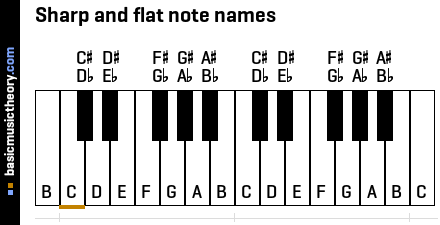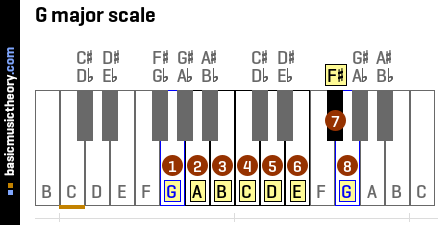G major key signature
The Solution below shows the G major key signature on the treble clef and bass clef.
The Lesson steps then explain how to write the key signature using both clefs, including the display order and line / space staff positions of the notes, and the sharp / flat accidentals.
For a quick summary of this topic, have a look at Key signature.
| Key | C | C# | Db | D | D# | Eb | E | E# | Fb | F | F# | Gb | [G] | G# | Ab | A | A# | Bb | B | B# | Cb | All On 1 page |
|---|
Solution
1. G major key signature
The G major scale has 1 sharp.
This major scale key is on the Circle of 5ths - G major on circle of 5ths, which means that it is a commonly used major scale key.
| No. | 1 | 2 | 3 | 4 | 5 | 6 | 7 | 8 |
|---|---|---|---|---|---|---|---|---|
| Note | G | A | B | C | D | E | F# | G |
These note names are shown below on the treble clef followed by the bass clef.


| Bass Clef: | Midi | MP3 | Treble Clef: | Midi | MP3 |
Lesson steps
1. Piano key note names
The white keys are named using the alphabetic letters A, B, C, D, E, F, and G, which is a pattern that repeats up the piano keyboard.
Every white or black key could have a flat(b) or sharp(#) accidental name, depending on how that note is used. In a later step, if sharp or flat notes are used, the exact accidental names will be chosen.

The audio files below play every note shown on the piano above, so middle C (marked with an orange line at the bottom) is the 2nd note heard.
| Bass Clef: | Midi | MP3 | Treble Clef: | Midi | MP3 |
2. G major scale notes
The G major scale has 1 sharp.
| No. | 1 | 2 | 3 | 4 | 5 | 6 | 7 | 8 |
|---|---|---|---|---|---|---|---|---|
| Note | G | A | B | C | D | E | F# | G |

To understand why the G major scale has 1 sharp, have a look at the G major scale page, which shows how to identify the note positions and names for this scale.
Since this is a sharp-based key signature, the music theory rules for constructing key signatures containing sharps are covered in the next step.
| Bass Clef: | Midi | MP3 | Treble Clef: | Midi | MP3 |
3. Writing a sharp-based key signature
Sharp key signature symbol order
The key signature is set of sharps or flats (never mixed) shown after the treble or bass clef on the musical staff.
The key signature symbols are always shown in the same order, no matter what the order of the actual notes on the staff.
For a sharp-based key signature (like this scale), the order is easily remembered using the following phrase, whose first letters indicate the note names to be sharpened:
Father Charles Goes Down And Ends Battle
So if the scale contains note F#, this is always the first sharp key signature symbol shown next to the treble or bass clef in the note F staff position(top line).
Then the same for C# in the second position, and so on for all the words in the phrase.
Sharp key signature order explanation
The Father Charles.. order for key signature symbol placement is not accidental, and follows the music theory pattern called the Circle of fifths.
Taking the 1st letter of the 1st word in the phrase - F, the 5th note of the major scale with its name as the tonic - F major scale is note C (the 2nd word of the phrase).
Now take the 5th note of the major scale whose tonic is C - the C major scale - this is note G (the 3rd word of the phrase).
Now take the 5th note of the major scale whose tonic is G - the G major scale - this is note D (the 4th word of the phrase), and so on.
Sharp key signature relationships
The other interesting thing about this phrase / pattern is that given any sharp symbol in the key signature, the symbols before that symbol will always exist.
For example, if a key signature has note B# (last phrase word / symbol), then it will always have the other 6 symbols before it.
Another example - if a key signature has note D# (4th word / symbol), then it will always have the first 3 symbols before it.
Put another way, if you see a key signature with 1 sharp, that sharp will always be F# (the first phrase word).
Or if a key signature has 2 sharps, those sharps will always be F# and C#.
To learn more about these patterns, have a look at Learn the circle of fifths.
The above rules apply to sharp-based key signatures - flat based key signatures have a similar set of rules, with the above phrase reversed. Have a look at the Cb major key signature.


The staff above is to demonstrate all possible sharp symbol positions in a key signature. In the next step, only those sharp positions in this particular scale will be used.
Difference between treble and bass clef key signature
For both the treble and bass clef, all key signature rules on this page are identical.
The only difference between them is that the bass clef symbols are shifted down to the next line or space (and of course the note pitches are lower on the bass clef).
This is to reflect the fact that all note positions on the bass clef are one line or space lower than the treble clef.
For example, on the treble clef, note C (2nd note shown) occupies the 2nd space from the top, whereas on the bass clef, the same note is the 3rd space from the top.
Equally, on the treble clef, note D (4th note shown) occupies the 2nd line from the top, whereas on the bass clef, the same note is the 3rd line from the top.
The bass clef symbols are dropped to the next position for flat-based key signatures in exactly the same way. Have a look at Cb major key signature for details.
A Key signature symbol covers the note on many octaves
The above staff diagrams show only one possible staff position for each note letter A to G, on each clef.
The specific note positions used to identify each note A..G above are just a convention used to group the key signature symbols neatly around the centre of the staff, but any symbol actually applies to that note in all octaves on a given clef.
This means that for the first symbol, F#, although the note and symbol are on the top line of the treble clef, the symbol really means 'Sharpen any F-Sharp note supplied on any octave in this clef, not just the F-Sharp pitch on this line'.
In reality, any note could occur in multiple octaves ie. appear more than once on the treble or bass clef, with a higher or lower pitch.
For example, in the final step below, you will see that the scale tonic / starting note appears twice on the both treble and bass clef.
4. G major key signature has 1 sharp
The key signature for this scale is shown below, with the key signature symbols in the correct order as per the phrase in the above step, and the note names in the same order as shown in Step 2.
| No. | 1 | 2 | 3 | 4 | 5 | 6 | 7 | 8 |
|---|---|---|---|---|---|---|---|---|
| Note | G | A | B | C | D | E | F# | G |


| Key | C | C# | Db | D | D# | Eb | E | E# | Fb | F | F# | Gb | [G] | G# | Ab | A | A# | Bb | B | B# | Cb | All On 1 page |
|---|